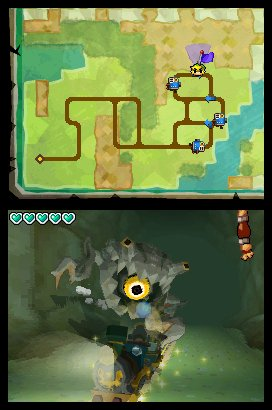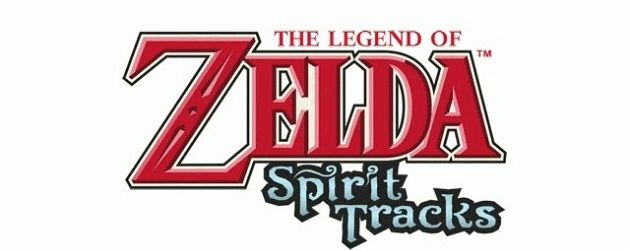System: Nintendo DS (Exclusive)
Developer: Nintendo
Publisher: Nintendo
Genre: Adventure
It’s always a phenomenal event when a new Zelda game hits store shelves. The legendary series has been going strong for over 20 years without a single bad entry (except Zelda II. And those awful CDi games don’t count either). Some of the games are better than others, sure, but every notch into the convoluted Zelda time line represents a timeless classic and a memorable adventure. Now that Spirit Tracks for the Nintendo DS, the latest entry into the renowned series, is finally here, it’s time once again to venture through the land of Hyrule on an epic quest to save Princess Zelda.
I was beyond psyched for the first DS Zelda adventure, Phantom Hourglass, before it came out. Everything I saw or read about the game got my underwear tight with anticipation. When I finally got to jump into the adventure, however, I was severely disappointed. Despite everything right the game had going for it, the slow and arduous sailing and absolutely painful Temple of the Sea King kept me from enjoying the title as much as I wanted to, even to the point where I declared it my least favorite handheld Zelda game. While the game was still fantastic overall, Zelda games have their own standards, and this was one of the weaker outings.
 Knowing Spirit Tracks is almost a direct sequel to the premiere DS outing, taking place roughly 100 years later, I found it much harder to get overly giddy about it. A look at trailers and screen shots reveals a game that is seemingly a mere extension of Phantom Hourglass, and I wasn’t ready to be disappointed by another Zelda game.
Knowing Spirit Tracks is almost a direct sequel to the premiere DS outing, taking place roughly 100 years later, I found it much harder to get overly giddy about it. A look at trailers and screen shots reveals a game that is seemingly a mere extension of Phantom Hourglass, and I wasn’t ready to be disappointed by another Zelda game.
Thankfully Spirit Tracks completely blows Phantom Hourglass out of the water in every way imaginable.
I’ll start by discussing the gameplay. Everything is controlled via the system’s touch screen. Just like Phantom Hourglass, this control scheme has its ups and downs. Jotting notes on your map, drawing a course for your train, and control over your projectile weapons and boomerang are just a few examples of the excellent innovations made possible by the system’s touch screen. But while completely solid and without fault most of the time, there will be instances where the lack of direct control via d-pad and the fact that your hand is almost constantly covering at least 50% of the screen will just get on your nerves.
The biggest addition to Link’s newest adventure is the introduction of trains to the series. Traversing the vast overworld, be it Hyrule or any other location, has always been one of the most magical parts of any Zelda adventure. The sea-faring expedition in Phantom Hourglass grew a bit tiresome halfway through the adventure, thanks mostly to the lack of scenery and things to do on the boat. On the Spirit Train, however, you will find traveling to be much more enjoyable thanks to a lush overworld full of animals, enemies, and scenery.
Another addition to Spirit Tracks is a new musical instrument; the Spirit Flute. This magical pan flute is the funnest instrument to have ever graced a Zelda game thanks to the innovative and interactive way you play it by literally blowing into the mic and sliding the flute around on the bottom screen to hit different notes. While this works excellently when being played under the right conditions, forget about being able to use any microphone driven tool in any noisy environment. In a car, on a bus, on your break at work, at a party, or at a boring movie, it is almost impossible to operate the Spirit Flute unless your surroundings are dead silent, which is a huge annoyance.
 The fact that the game doesn’t tend to get tedious during travel is excellent, because the scope of this adventure is much bigger than it was in Phantom Hourglass. Though there are only four main dungeons, all of the outposts and towns which you can explore and perform sidequests in definitely adds plenty of length to the adventure.
The fact that the game doesn’t tend to get tedious during travel is excellent, because the scope of this adventure is much bigger than it was in Phantom Hourglass. Though there are only four main dungeons, all of the outposts and towns which you can explore and perform sidequests in definitely adds plenty of length to the adventure.
The place in the game where you’ll spend most of your time is the Spirit Tower, which is essentially a dungeon consisting of over two dozen floors of some of the most brilliant and innovative puzzles I’ve ever seen in a Zelda game, all revolving around the touch screen and your ability to control both Link and Zelda. After every main dungeon you clear out you will return to the Tower to fight your way through another chunk of it in search of another section of the Overworld’s map, very similar to the Temple of the Sea King. Unlike Phantom Hourglass’s repetitive grindfest, however, once you make your way to a section of Railmap there is no need to replay that part of the Tower ever again.
The game also happens to be gorgeous. Beautiful cel-shaded 3D character models and landscapes come to life with vibrant colors and creative architecture. The time you spend on the rails conducting your way through Hyrule presents some of the most visually stunning scenery the DS has ever pumped out. While there may be some graphical pop up it is minimal and easy to ignore. Perhaps the most impressive aspect to Spirit Tracks’ visuals are the new cut scenes. Every scene is expertly crafted, presenting the story in a very cinematic way. Though I do find it annoying that the characters’ mouths never move and their facial expression rarely change.
Also top notch is the soundtrack. Every single tune in the game’s wonderful score fits the mood of the adventure perfectly. I didn’t find a single song throughout the entire adventure that I didn’t enjoy. The sound effects are all great as well, and get the job done perfectly.
Final Words:
Spirit Tracks is one of the most satisfying and epic Zelda games to ever hit a handheld system. Gorgeous visuals, innovative gameplay, amazing boss fights and brilliant puzzles are just some of the elements that come together beautifully to help create a fantastic Zelda experience.Though certainly not perfect, the flaws are easily overlooked in presence of all the game does right, and it is truly impressive how much better than Phantom Hourglass this adventure is.
I highly recommend The Legend of Zelda: Spirit Tracks.
Pros
- A grand, epic adventure
- Gorgeous visuals and sound
- The Spirit Flute
- Tons of innovation
Cons
- Touch controls occasionally aren’t responsive enough
- Good luck playing the Spirit Flute properly if you aren’t in dead silence
Score: 9.3/10 (Outstanding)
Gameplay: 9.5/10
Visuals: 9.0/10
Audio:9.25/10
Entertainment Value:9.5/10


This game is on my xmas list. Hopefully santa finds me deserving. I’m really surprised by how well it’s being received after everyone criticized it by saying it was nothing more than Phantom Hourglass on a train.
Pingback: Tweets that mention [Game Review] The Legend of Zelda: Spirit Tracks (DS) -- Topsy.com
my sister broke my r4
Trust me on this, brad, it’s worth the money.